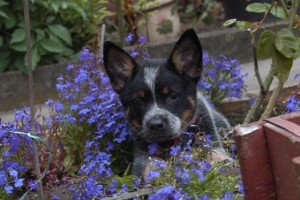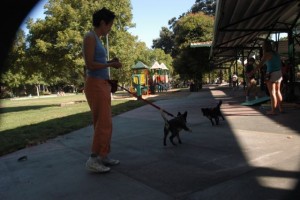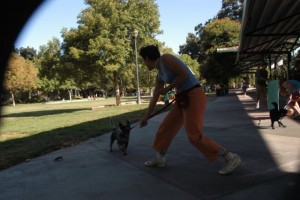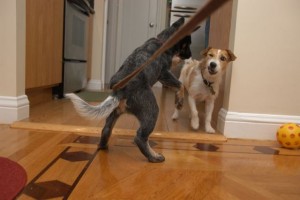
When we last left off, I’d dropped Lucy, the 8 week old Australian Cattle dog with my parents after taking a week to train her through the puppy learn to earn program at my house. Before I brought her down, she seemed virtually perfect. She would automatically sit to be petted, to get her leash on, to go out the door, to have her toy tossed, and even when she greeted guests, including young toddlers. She could fetch and would chew on appropriate toys. And she could walk on leash in heel position and come when called even away from playing with other puppies.
Then I brought her to my Dad, with the hopes that if my parents could just continue to reward the behaviors I had just trained she’d be almost as well-behaved for them. It sounded so simple, until on day one at their house she immediately decided, they didn’t exist. They were far too slow to deliver the treat while she was behaving or sitting and looking at them, so she’d immediately run off and do something else. Luckily, the Puppy Learn to Earn program starts with the puppy on leash at all times when the owners are home so she had to stick near my dad thus giving him a better chance to reward good behavior. After a full day attached to him earning her meal throughout the day, Lucy finally started sitting and looking at him. They finally started bonding. And it was a good thing since I would be unable to return to check their progress for several weeks.
Hints of Lucy’s Bad Behavior
In the weeks that I was away, it was clear my dad and Lucy were bonding. “Lucy licks me when I carry her,” or “Lucy’s doing better at sitting for us,” he would report.
But then came the email reports from my mom when I was traveling several days later. “She’s still pottying in the house, what should we do?” “Lucy’s chewing on our arm, how come?” ” She keeps grabbing her leash on walks. How do we stop that?” Now these seem like typical questions anyone might have, but that would be people who did not already have a 35-page 100-photo book specifically detailing how their puppy had been trained. So my answers included statements, such as ” Did you read and look at the photos on pages 1–8 on how to potty train Lucy, or p 19 on nipping? Or watch the instructional videos I sent on how to perform the exercises?”
Even though my dad doesn’t like to read in English, I had hoped he would at least look at the photos. Yeah, right.
Anyway, based on their reports, when I finally visited them about two weeks after I’d last seen her I wasn’t surprised by her bad behavior. On a positive note, my parents had walked her twice a day through the neighborhoods of San Francisco where she’s greeted many people and received treats for sitting. So she was much more comfortable around cars, buses, individual and crowds of people, as well as fire engines, dump trucks and the other city sounds that and sights that could scare dogs who didn’t get such experiences before 12 weeks of age. On the other hand two weeks ago we had a sweet puppy who sat for petting, treats, to be greeted, to get leash on and on walks whenever we stopped, now Lucy was a jumping maniac. That in itself wasn’t that bad, nor was the fact that she was still an angel when I walked her on leash but a little monster when my dad tried. She would stop and grabs leaves or lunge randomly in different directions or grab the leash and play tug. What was really bad was the things she learned in her puppy class. I saw them first hand when I went.
Puppy socialization class started as close to 8 weeks of age as possible is supposed to solve or prevent a number of problem issues from developing in puppies. In class, owners should practice handling their puppies and teaching their puppies that remaining calm to have their feet, ears, tail, and mouth examined is good. Puppies should also learn how to play nicely with other puppies and dogs, that humans in general are safe and friendly, and that even in the high excitement environment of a class with other puppies and people, they should be able to calm down and focus on their owners.
That’s in theory what puppies are supposed to learn, but what Lucy learned was exactly the opposite. In the class, the instructor started with handling exercises. Lucy’s breeder had started these during Lucy’s first weeks, so Lucy had been good with me, all of my student volunteers, and my parents from day 1. But during class, the problem was that she wanted to play with the puppies so she was struggling and more agitated overall and my parents didn’t know how to hold her to prevent this. You’d think I would jump in and help, but not wanting to miss the educational opportunity or to interfere in the instructor’s class, I just videotaped the evidence as the bad behavior played out.
First Lucy just struggled in short bursts. But next thing she was growling. The room was fairly quiet with everyone sitting in a circle, so the growling was like a megaphone to me. The instructor seemed oblivious. I asked her what she wanted my parents to do in this type of situation. Her answer told me she hadn’t been watching. She started explaining how to reward Lucy for allowing her feet to be handled when the actual problem was that my parents had not been holding Lucy effectively. (Note: I know this because I had spent the previous year writing a photoillustrated book and DVD called Low Stress Handling, Restraint and Behavior Modification of Dogs and Cats. This involved videotaping and analyzing exactly what technicians, veterinarians and other animal healthcare staff were doing right and wrong when handling animals. And then photographing both correct and incorrect techniques. The book has 1600 color photos).
Not that her instruction was wrong. My parents were actually doing the desensitization and counterconditioning incorrectly. They were randomly giving treats and handling her feet, rather than giving treat at the same time or within a split second of handling the feet so that Lucy could make the connection. The funny thing was that they looked so happy when they were doing it, even when Lucy was struggling and growling. So as I looked through the video camera lens in horror, they were enjoying their new puppy.
I watched as the instructor patiently explained and demonstrated the correct method of feeling the feet and then rewarding for good behavior with a treat. The problem is that after the first few times, her technique changed. She would feel the feet and sometime take over 3 seconds to follow with a treat making it difficult for Lucy to associate the reward with the foot handling. Then, not surprisingly, as soon as the instructor walked away, my parents went back handling Lucy’s feet or mouth and randomly giving her treats, as they had been before. So they clearly hadn’t understood what the instructor had told them. Mental note to self: Have hidden video of participants in my own dog classes to see how frequently this happens. Luckily in my classes I have one assistant per every 2–3 participants.
Next, it was time for puppy play session. The instructor had us let the puppies loose, all 8 at one time and now I understood why Lucy’s behavior was so bad. In my puppy classes I tend to only let two or three puppies off leash at a time while dragging a leash, and I match the puppies based on personality and play style. These puppies only get to play this way after they can focus well on their owners when around the other puppies. Otherwise the puppies will just learn how to blow their owners off.
And ignoring people is exactly what Lucy learned. She’d run and jump on a puppy and wrestle for up to 30 seconds and the run and jump on another. She raced back and forth as the other owners laughed, “Lucy’s the fastest one.” Personally, when everyone in the class is at a consensus that one puppy is the wildest one and that puppies owners are also the oldest senior citizens in the class, that raises a huge red flag. These owners will need lots of one-on-one help if they plan to keep the puppy in their family for a long time or to raise a canine good citizen instead of doggie juvenile delinquent.
Next the instructor started the exercise called “Catch the puppy,” where people would grab a puppies collar and then give them a treat. The goal is that the puppy learns that it’s good to be grabbed by the collar. The problem is that for puppies to make the connection for sure, it’s best to grab their collar and follow with a treat 5–10x in a row and in multiple sessions until the puppy actively look to you for a treats whenever his collar is grabbed. What Lucy was learning was that she didn’t like having her collar grabbed, it meant she wouldn’t get to play. This learning was clear, later in the class when the instructor was stepping on the leash I’d put on Lucy so that she could observe Lucy better. A puppy owner went to grab Lucy’s collar and Lucy turned, flashed her teeth, and growled. The instructor didn’t notice. So much for observing her better.
This collar grabbing technique became even less effective when the instructor stated, “Now when you grab the puppy, have him sit, and then lie down and then stand.” Now all of a sudden the room was filled with demands of “sit, sit, sit, sit…” Then when a puppy owner caught Lucy and Lucy was too interested in other dogs to pay attention to the treat, the instructor instructed, “First tell her to sit.” By then Lucy, who knows to automatically sit when she can’t get what she wants, was sitting. Regardless, the instructor repeated, “tell her to sit.” So the puppy owner said “sit” to Lucy who was already sitting, and then gave her a treat. Now, not only was Lucy learning that collar grab means cessation of play, but she was learning her cue to sit (or to not sit in cases where she was too distracted to sit) was “sit, sit sit sit sit.” Unfortunately, I didn’t get this on tape.
The rest of the class Lucy’s behavior continued to deteriorated. She became more and more aroused around the other puppies. She was happy to be the puppy on the bottom of the pile and play on her back, but she pounced on the puppies the way football player pounce on a fumbled football. She could not focus on me or my parents or hold still-especially since even when she was being held by her collar, other puppies might still be running around and jumping on her.
So, in just 2 puppy classes and a little over two weeks with my parents, she’d turned from a calm, sweet, polite puppy, to a puppy with impulse control and the start of aggression issues.
Effects Extend Beyond Class
Needless to say, I took her out of the class and took her back with me to work with her more. Once at my house, I was able to confirm that my worries were correct. Now when Jonesy, my Jack Russell Terrier, growled at Lucy to get her to back off, she would leap on him more excitedly instead of backing down to the more mature dog like she had two weeks ago. This behavior was repeated with two other test dogs similar in size. They grew tired of her repeated attempts to play roughly with them and when they voiced their opinions with growls, she escalated by growling and lunging more. In other words, she was learning to harass other dogs at will and then get into a fight when they growl at you. And she was only just over 10 weeks at this point in time. On top of this, if there was a dog in the same room or within 15 feet of her she had to lunge to try to get at it whereas before she could easily focus on me and even come when called away from puppy play.
With all that had gone wrong in just two puppy classes and a little over two weeks, I wondered, now how long would it take to retrain the bad behavior out of her and reestablish the good behavior from that first week? And once that was established how long would I need to train her before the good behavior could become a habit? Find out in the upcoming blogs.
I can say this, as a result of her bad behavior, I added about 150 more pages and hundreds more photos to the Lucy’s training manual book.






